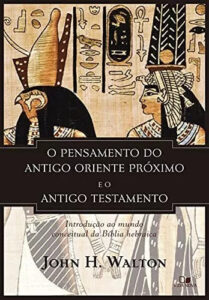Recomendo ler antes o post Cosmogonias, publicado no Observatório Bíblico em 29.11.2024.
Agora, um trecho do capítulo 8, Cosmologia e cosmogonia, do livro de WALTON, J. H. O pensamento do Antigo Oriente Próximo e o Antigo Testamento. São Paulo: Vida Nova, 2021.
Ênfase na ordem funcional do primeiro dia
Em Gênesis 1,3-5, na análise sobre a luz do primeiro dia, fica claro que, para os israelitas, o foco da Criação estava na ordem, não nos objetos.
Em Gênesis 1,5a, a NIV traduz: “Deus chamou à luz (ʾor) ‘dia’ (yom) e às trevas chamou ‘noite’”. Se Deus chamou à luz yom, por que em todo o Antigo Testamento os autores continuam chamando à luz ʾor?
É uma pergunta que qualquer um poderia responder depois de refletir um pouco: não foi o elemento da luz em si (como os físicos o analisariam) que Deus chamou yom, mas o período de luz.
Há um termo para o fenômeno semântico observado aqui, a saber, metonímia. Na metonímia o significado de uma palavra é estendido para abranger coisas intimamente relacionadas a ela. Quando se diz que a Casa Branca faz uma declaração, ninguém entende que é o prédio que está falando.
Por consequência, não é a luz estudada pelos físicos que está sendo chamada de yom, mas, sim, o período da luz — algo bastante óbvio, pois é com esse sentido que a palavra yom é usada com frequência no restante das Escrituras.
Mas, caso a palavra ʾor se refira a um período de luz no versículo 5, o que dizer do versículo 4? Ali Deus separa a luz das trevas. De novo descobrimos que “período de luz” é muito mais plausível aqui. A luz estudada pelos físicos não pode ser separada das trevas, mas é possível estabelecer períodos alternados de luz e trevas.
Ainda não podemos parar nisso. Se o texto quer que entendamos “período de luz” tanto no versículo 4 quanto no 5, o que dizer do versículo 3?
Creio que a coerência hermenêutica nos levaria a crer que, quando Deus disse “Haja ʾor”, temos então de entender a ordem como “Haja um período de luz”.
Só poderíamos concluir, então, que o primeiro dia não diz respeito à criação da luz como entendida pelos físicos, isto é, à “luz” como um elemento físico com propriedades físicas.
O dia um diz respeito a algo muito mais significativo, algo muito mais elementar ao ordenamento do cosmo e à nossa experiência do cosmo. No primeiro dia, Deus criou o dia e a noite; seus períodos alternados formam o tempo.
Functional Order Emphasis in Day One
In Genesis 1:3–5, in the discussion of the first day’s light, it becomes clear that for the Israelites order, not objects, was the focus of creation.
In Genesis 1:5a the NIV translates, “God called the light (ʾor) ‘day’ (yom) and the darkness he called ‘night.’” If God called the light yom, why do the authors continue throughout the Old Testament to call light ʾor?
It is a question anyone could answer with a little thought: it was not the element of light itself (as physicists would discuss it) that God called yom, but the period of light.
There is a term for the semantic phenomenon that is observed here—namely, metonymy. In metonymy the meaning of a word is extended to include things closely related to it. When the White House makes a statement, it is understood that the building is not talking.
Consequently, it is not the physicist’s light that is being named yom, it is the period of light—obvious enough because that is what yom is often used to refer to in the rest of Scripture.
But if the word ʾor refers to a period of light in verse 5, what about in verse 4? There God separates the light from the darkness. Again we find “period of light” much more plausible here. The physicist’s light cannot be separated from darkness, but alternating periods of light and darkness can be set up.
Still we cannot stop there. If the text means for us to understand “period of light” in both verses 4 and 5, what about verse 3?
Hermeneutical consistency, I think, would lead us to believe that when God said “Let there be ʾor,” we must then understand it as “Let there be a period of light.”
We could only conclude, then, that day one does not concern itself with the creation of the physicist’s light—that is, “light” as a physical element with physical properties.
Day one concerns something much more significant, something much more elemental to the ordering of the cosmos and to our experience of the cosmos. On day one, God created day and night; their alternating periods constitute time.
3 וַיֹּאמֶר אֱלֹהִים יְהִי אוֹר וַיְהִי־אוֹר׃
4 וַיַּרְא אֱלֹהִים אֶת־הָאוֹר כִּי־טוֹב וַיַּבְדֵּל אֱלֹהִים בֵּין הָאוֹר וּבֵין הַחֹשֶׁךְ׃
5 וַיִּקְרָא אֱלֹהִים לָאוֹר יוֹם וְלַחֹשֶׁךְ קָרָא לָיְלָה וַיְהִי־עֶרֶב וַיְהִי־בֹקֶר יוֹם אֶחָד׃ ף
